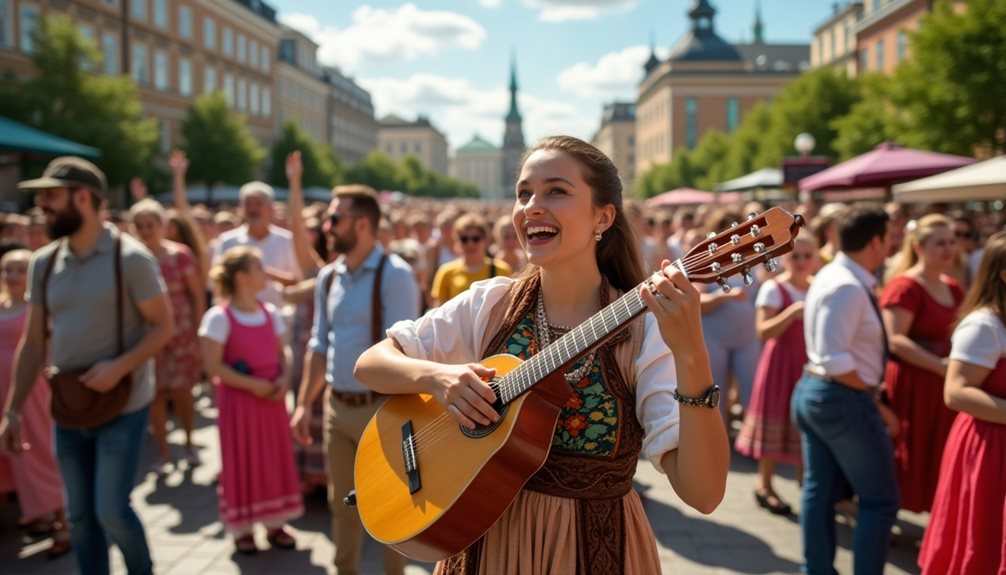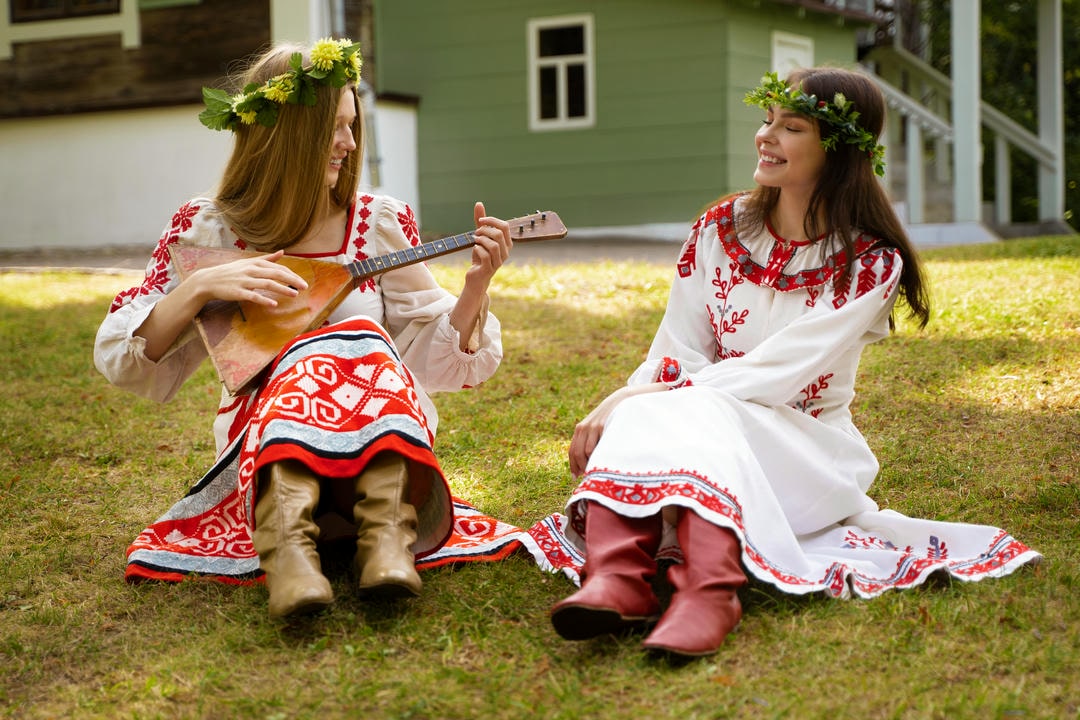Kalinka stands as a quintessential representation of Russian cultural identity. Its catchy melodies and rhythmic allure have captivated audiences for generations. Composed by Ivan Larionov in the 19th century, the song intertwines themes of nature, beauty, and love, reflecting the essence of Russian folk traditions. Its rise during pivotal historical moments hints at a deeper significance. To fully appreciate the song’s impact, one must explore the intricate connections between its origins and its lasting legacy.
Introduction

In exploring the world of Russian folk music, one song stands out as a quintessential representation of the nation’s cultural heritage: Kalinka.
This lively tune encapsulates the essence of Russian instruments, often accompanied by balalaikas and accordions, enhancing its vibrant sound. Kalinka is frequently performed during traditional dances at folk festivals, where participants celebrate community and heritage.
The song serves as a powerful vehicle for musical storytelling, weaving narratives of love and nature. As Russia embraces cultural preservation, Kalinka remains a pivotal symbol, connecting generations and reminding both locals and global audiences of the richness of Russian folklore.
Folk Music in Russian Culture

Russian folk music plays a vital role in shaping the nation’s identity, intertwining its cultural, historical, and social narratives. This genre reflects the spirit of the people, celebrating their heritage through distinct musical instruments and dynamic dance traditions.
The storytelling embedded in these songs conveys values, struggles, and joys, preserving memories across generations. As both a communal and individual expression, folk music fosters belonging, reinforces national pride, and invites global appreciation, enriching the broader cultural landscape.
Kalinka: A Cultural Icon
Emerging in the 19th century, Kalinka is a lively song deeply rooted in Russian traditions. Its energetic rhythms are brought to life by instruments like the balalaika and accordion. Regional variations showcase local dances and reflect diverse influences across Russia. The lyrics often celebrate themes such as nature, love, and collective joy, resonating with the shared experiences of its people.
Understanding the song’s historical context enhances its significance as a cultural artifact. Beyond entertainment, it preserves Russian heritage and unites listeners through its enduring charm.
Composed by Ivan Larionov in 1860
Ivan Larionov composed Kalinka in 1860 for a theatrical performance in Saratov. Drawing inspiration from Russian folk traditions, the song’s vibrant melodies and rhythms captured the essence of the nation’s spirit during a period of musical evolution. Its theatrical debut allowed it to resonate widely, embedding itself in Russian culture.
The song’s infectious energy and relatable themes have ensured its lasting appeal, making it a beloved symbol of Russian identity.
Larionov’s inspiration from Russian folk traditions and his travels collecting songs
Drawing inspiration from the vibrant fabric of Russian folk traditions, Ivan Larionov initiated a journey across the vast landscapes of Russia, collecting melodies and stories that would eventually shape his iconic composition, Kalinka.
His travels allowed him to immerse himself in the diverse musical practices of various regions, each contributing unique rhythms and themes to his repertoire.
Through song collection, Larionov engaged in a profound cultural exchange, blending local flavors into a cohesive narrative.
This musical storytelling not only honored Russian folklore but also created a lasting connection among communities, celebrating the rich heritage that continues to inspire generations.
Early Popularity
Since the 19th century, Kalinka has captivated audiences across Russia and beyond, becoming a cherished part of the nation’s musical heritage. Its early performances showcased vibrant folk influences, marked by lively tempos and memorable melodies. The lyrics, often celebrating nature and love, resonated deeply with listeners, creating an emotional bond.
The song’s structure, featuring a catchy chorus and engaging rhythm, encouraged audience participation, further boosting its popularity. As Kalinka won over Russian hearts, its charm caught the attention of Dmitry Agrenev-Slavyansky, a key figure in reviving Russian folk music.
Cultural Exchange
By incorporating Kalinka into his Folk Choir’s repertoire, Agrenev-Slavyansky facilitated a significant cultural exchange. The choir’s performances, characterized by vibrant harmonies and dynamic rhythms, allowed listeners to experience the song’s essence, transcending language barriers. This strategic move celebrated traditional Russian culture and opened doors for global dialogue, fostering appreciation among diverse communities captivated by Kalinka’s spirited melodies.
The song’s appeal is largely due to its catchy chorus and dynamic tempo, creating an unforgettable auditory experience. The melodies, intertwined with traditional folk instruments, evoke a sense of joy that resonates globally. The increasing tempo invites listeners to engage in vibrant dance traditions, fostering cultural exchange.
Kalinka’s infectious rhythm has led to numerous global collaborations, allowing it to transcend geographical boundaries. As audiences worldwide embrace its lively essence, the song stands as a symbol of music’s power in uniting diverse cultures through shared enjoyment and celebration.
World War II and Revival
During World War II, Kalinka experienced a remarkable resurgence, embodying the resilience and national pride of the Russian people. The song’s lively melody united soldiers and civilians, serving as a beacon of hope amidst conflict. Rooted in folk traditions, its infectious rhythms invigorated the populace, reflecting their enduring strength.
The integration of Kalinka into the Alexandrov Ensemble’s repertoire marked a pivotal moment in Russian cultural history. It became a powerful symbol of wartime resilience, encapsulating the spirit of a nation under siege. As part of the ensemble’s performances, Kalinka showcased Russia’s rich musical heritage, fostering cultural unity and artistic diplomacy.
On the frontlines, performances of Kalinka captivated both Soviet troops and enemy forces, creating a unique phenomenon that transcended conflict. The lively rhythms and emotive lyrics fostered emotional connections, enabling unexpected cross-cultural exchanges. Soldiers from opposing sides found common ground in the infectious melody, momentarily setting aside their differences.
Global Recognition
As Kalinka gained global momentum, it became a tribute to the power of folk traditions in fostering cultural exchange. The song inspired international collaborations, uniting artists who embraced its energy. Music festivals worldwide showcased Kalinka, introducing diverse audiences to its rhythmic charm and traditional instruments.
Post-war performances by the Alexandrov Ensemble elevated Kalinka’s status internationally, particularly through operatic renditions that infused traditional folk elements with theatrical grandeur. These performances served as musical diplomacy, fostering cultural exchange during a time of global tension.
Kalinka’s influence has extended far beyond Russia, permeating popular culture through films, video games like Tetris and Civilization VI, and major events such as the FIFA World Cup closing ceremony in 2018. Its cultural significance is evident in its use of folk instruments and traditional dances, enchanting audiences worldwide.
Connection to Russian Identity
Kalinka holds a profound connection to Russian identity, serving as both a cultural emblem and a symbol of the nation’s artistic heritage. Its vibrant melody and rhythmic energy have made it a cornerstone of Russia’s musical legacy, frequently showcased on international stages. Through its lively performances, Kalinka highlights the richness of Russian folk traditions, offering audiences worldwide an authentic glimpse into the country’s cultural spirit.
The song’s universal appeal lies in its infectious rhythm and themes that transcend borders, fostering appreciation for Russian culture. By blending storytelling with traditional instruments and dance, Kalinka has become a key element in cultural exchanges, uniting diverse communities while celebrating its origins.
Metaphors of Beauty, Nature, and Love
The lyrics of Kalinka are steeped in metaphors that celebrate beauty, nature, and love. The titular “kalinka,” or snowball tree berry, symbolizes youth and liveliness, while the imagery of lush landscapes evokes a deep connection to the natural world. Themes of love are intricately expressed through poetic language, capturing emotions of longing and admiration.
These layers of meaning resonate across cultures, reflecting the universal appeal of Kalinka. Its lyrical depth invites listeners to explore not just a song but an enduring expression of human emotion tied to Russia’s cultural roots.
Timeless Appeal
The enduring popularity of Kalinka underscores music’s ability to transcend boundaries and connect people through shared experiences. Rooted in traditional instrumentation and lively rhythms, the song has inspired countless global collaborations and modern interpretations. Its role in revitalizing folk dance traditions further cements its status as a cultural icon.
From operatic renditions by the Alexandrov Ensemble to appearances in video games like Tetris and global events such as the 2018 FIFA World Cup closing ceremony, Kalinka continues to captivate audiences. It stands as a testament to Russia’s rich musical heritage while fostering connections among diverse communities worldwide.





